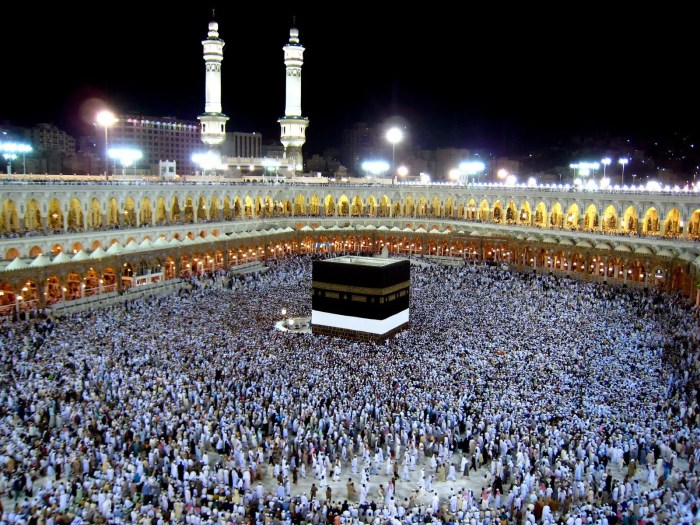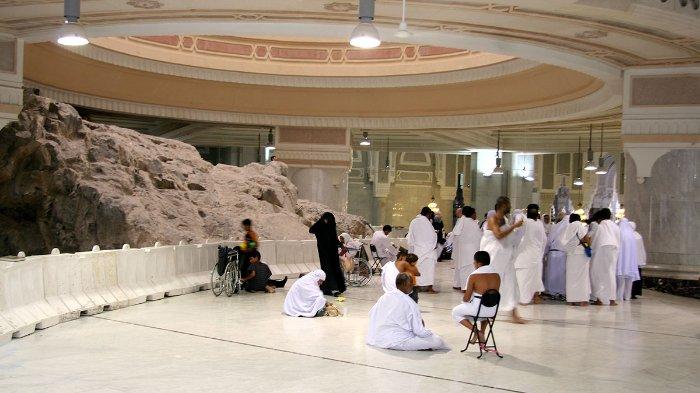Hajj is one of its pillars crossword – The hajj is one of the five pillars of Islam, a pilgrimage to Mecca that is required of all able-bodied Muslims at least once in their lifetime. It is a deeply spiritual and meaningful experience, and it is also a popular crossword puzzle clue.
In this article, we will explore the significance of the hajj, its history, and its rituals. We will also discuss the economic and social impact of the hajj, and we will look at how it has been depicted in literature, art, and film.
Significance of Hajj in Islam
Hajj is one of the five pillars of Islam, and it is considered to be one of the most important religious obligations for Muslims. The pilgrimage to Mecca is a spiritual journey that allows Muslims to connect with their faith and with other Muslims from around the world.
Hajj is a time for reflection and renewal, and it is an opportunity to seek forgiveness for sins and to ask for God’s blessings.
Examples of Hajj’s Unity and Devotion
- During Hajj, Muslims from all over the world come together in Mecca to perform the same rituals.
- The white garments that pilgrims wear during Hajj symbolize unity and equality.
- The rituals of Hajj are designed to help pilgrims to focus on their faith and to connect with God.
Historical Context of Hajj

The origins of Hajj can be traced back to the time of the Prophet Muhammad. Muhammad was born in Mecca in 570 CE, and he began preaching Islam in 610 CE. In 632 CE, Muhammad led his followers on a pilgrimage to Mecca, and this pilgrimage became the model for the Hajj that is performed today.
Role of Prophet Muhammad in Hajj
- Muhammad established the rituals and practices of Hajj.
- Muhammad taught that Hajj is a way to purify oneself from sin.
- Muhammad encouraged his followers to perform Hajj if they were able to do so.
Rituals and Practices of Hajj

The rituals of Hajj are designed to help pilgrims to focus on their faith and to connect with God. The most important rituals of Hajj include:
Tawaf
Tawaf is the circumambulation of the Kaaba, which is a cube-shaped building located in the center of the Grand Mosque in Mecca. Tawaf is performed seven times, and it is believed to represent the unity of Muslims around the world.
Sa’i
Sa’i is the running between the hills of Safa and Marwa. Sa’i is performed seven times, and it is believed to commemorate the journey of Hagar, the wife of the Prophet Abraham, as she searched for water for her son, Ishmael.
Standing at Arafat
Standing at Arafat is the most important ritual of Hajj. Arafat is a plain located about 20 kilometers east of Mecca. Pilgrims stand at Arafat on the ninth day of Hajj, and they spend the day in prayer and reflection.
Economic and Social Impact of Hajj

Hajj has a significant economic impact on the host country and the surrounding region. The pilgrimage generates billions of dollars in revenue each year, and it creates jobs for thousands of people. Hajj also has a social impact, as it brings together Muslims from all over the world and allows them to share their culture and traditions.
Economic Impact
- Hajj generates billions of dollars in revenue each year.
- Hajj creates jobs for thousands of people.
- Hajj stimulates the local economy.
Social Impact
- Hajj brings together Muslims from all over the world.
- Hajj allows Muslims to share their culture and traditions.
- Hajj promotes understanding and tolerance between different cultures.
Challenges and Opportunities for Hajj
Hajj is a challenging experience, but it is also an opportunity for spiritual growth and renewal. Some of the challenges that pilgrims face include:
Challenges
- Overcrowding
- Heat and humidity
- Lack of access to food and water
- Safety concerns
Opportunities
- Hajj is an opportunity for spiritual growth and renewal.
- Hajj is an opportunity to connect with other Muslims from around the world.
- Hajj is an opportunity to learn about Islam and its history.
Cultural Representations of Hajj
Hajj has been depicted in literature, art, and film for centuries. These representations have helped to shape the way that Muslims and non-Muslims view the pilgrimage.
Literature
- The Quran contains many verses about Hajj.
- Many Muslim poets and writers have written about Hajj.
- Hajj is a common theme in Islamic literature.
Art
- Hajj is often depicted in Islamic art.
- Paintings, sculptures, and other works of art have been created to commemorate Hajj.
- Hajj is a popular subject for Islamic calligraphy.
Film, Hajj is one of its pillars crossword
- Hajj has been the subject of several films.
- These films have helped to raise awareness of Hajj and its importance.
- Hajj films have been produced in a variety of countries.
Hajj in the Modern World: Hajj Is One Of Its Pillars Crossword

Hajj has changed significantly over the centuries. In the past, Hajj was a difficult and dangerous journey. Today, Hajj is much easier to perform, thanks to modern transportation and technology.
Changes in Hajj
- Hajj is now more accessible than ever before.
- Hajj is now safer than ever before.
- Hajj is now more comfortable than ever before.
Impact of Technology
- Technology has made Hajj easier to perform.
- Technology has made Hajj safer.
- Technology has made Hajj more comfortable.
Future of Hajj
The future of Hajj is uncertain. Some experts believe that Hajj will continue to grow in popularity, while others believe that the number of pilgrims will decline. It is also possible that Hajj will be affected by climate change and other global challenges.
Potential Developments
- Hajj could become more accessible in the future.
- Hajj could become more sustainable in the future.
- Hajj could become more technologically advanced in the future.
Challenges
- Hajj could be affected by climate change.
- Hajj could be affected by other global challenges.
- Hajj could be affected by political instability.
Quick FAQs
What is the hajj?
The hajj is a pilgrimage to Mecca that is required of all able-bodied Muslims at least once in their lifetime.
What are the five pillars of Islam?
The five pillars of Islam are the declaration of faith, prayer, fasting, almsgiving, and the hajj.
When is the hajj?
The hajj takes place during the Islamic month of Dhul-Hijjah.
How long does the hajj last?
The hajj lasts for five days.
What are the rituals of the hajj?
The rituals of the hajj include circumambulating the Kaaba, running between the hills of Safa and Marwa, and standing on the plain of Arafat.